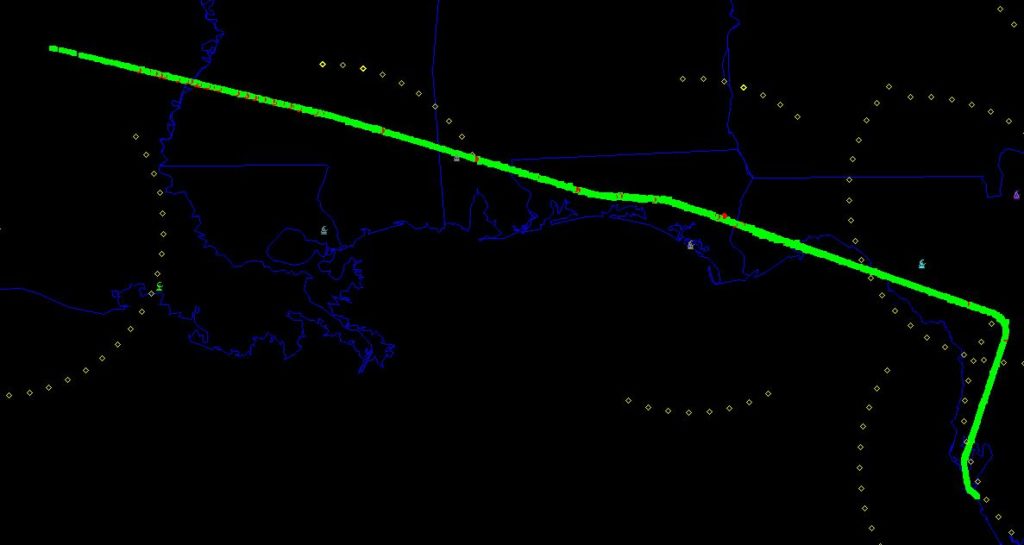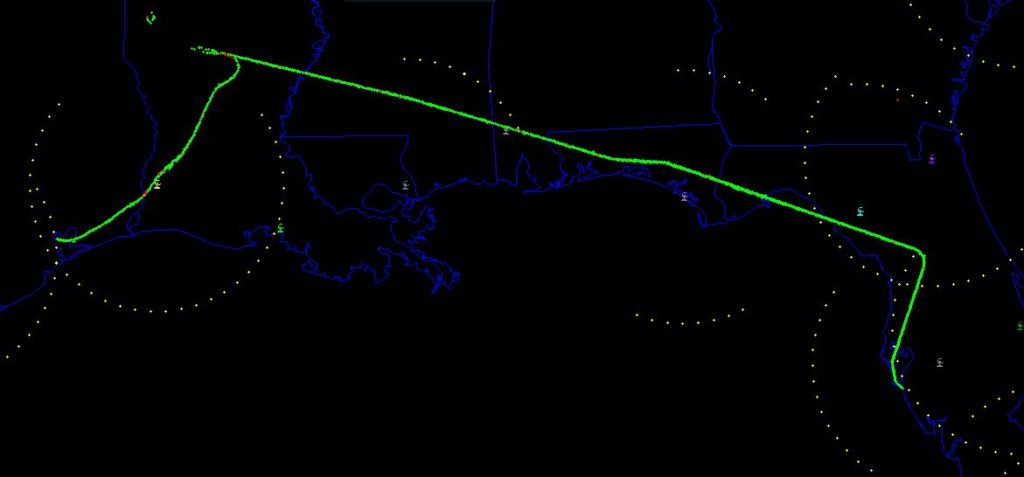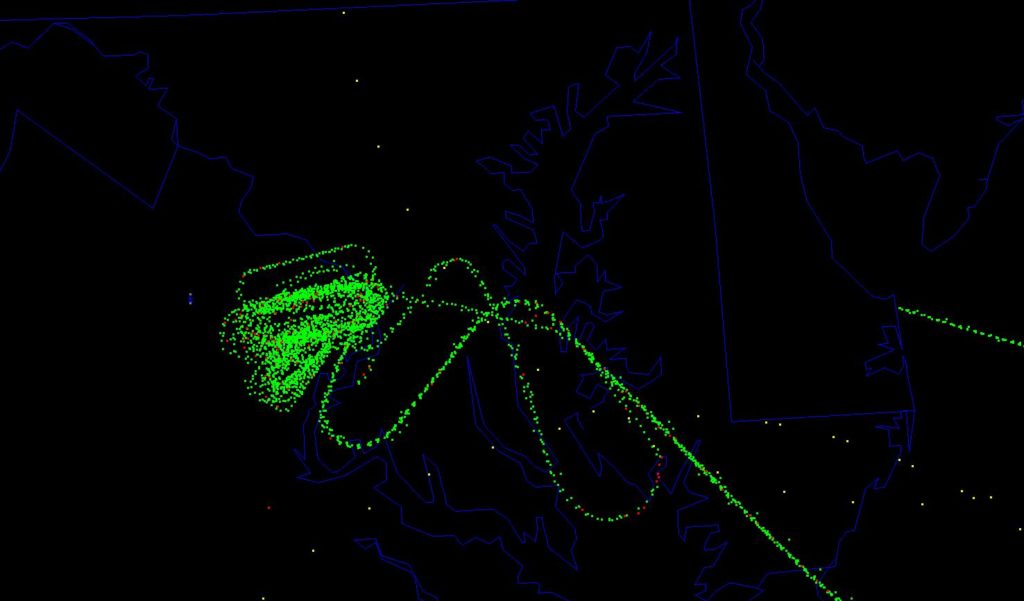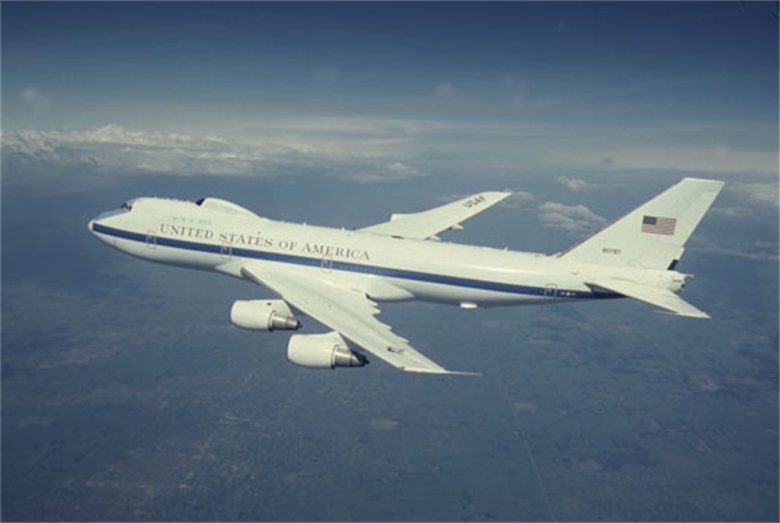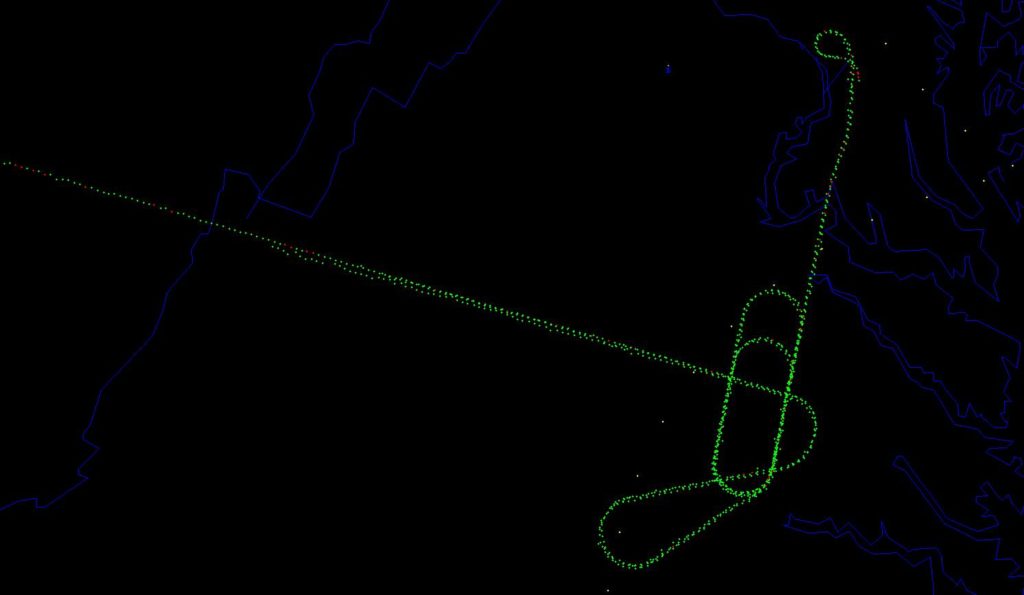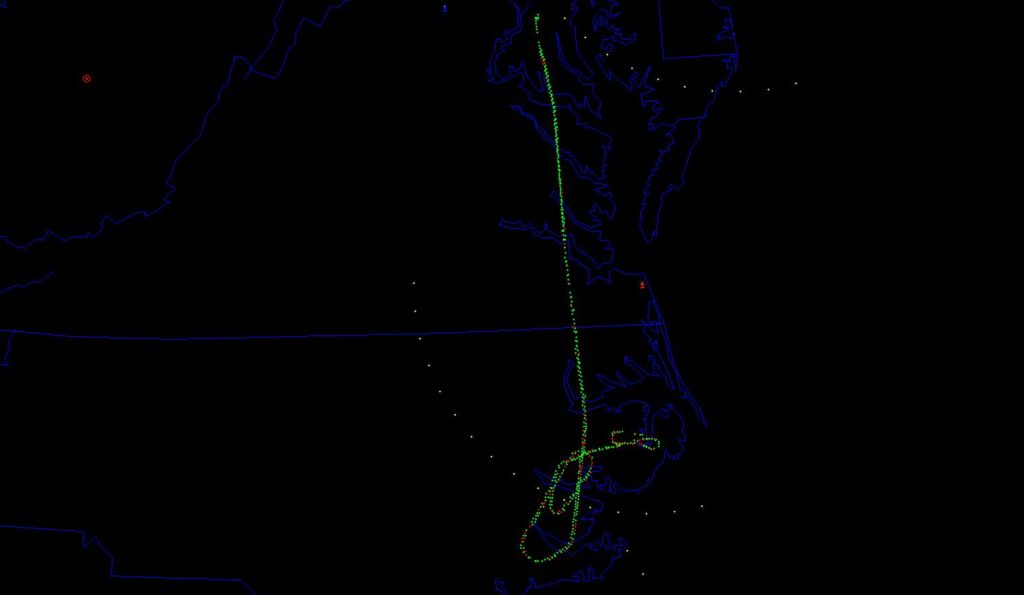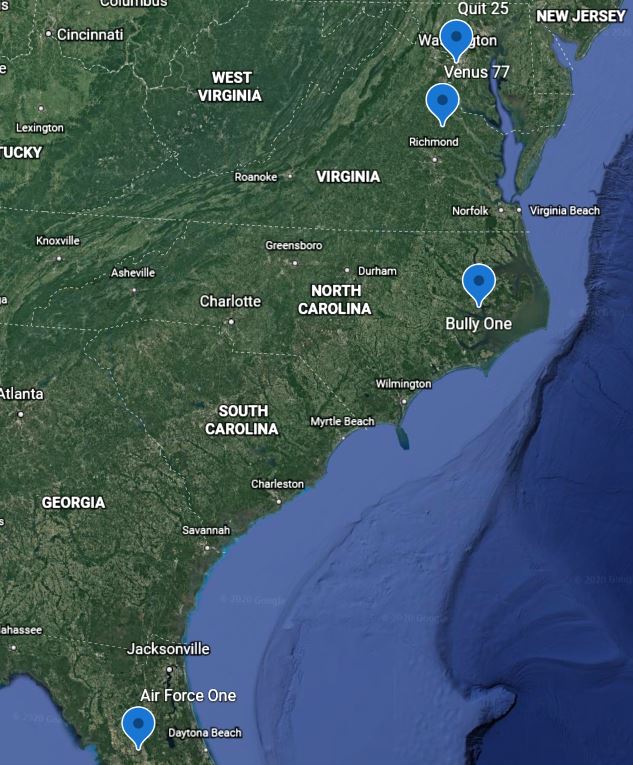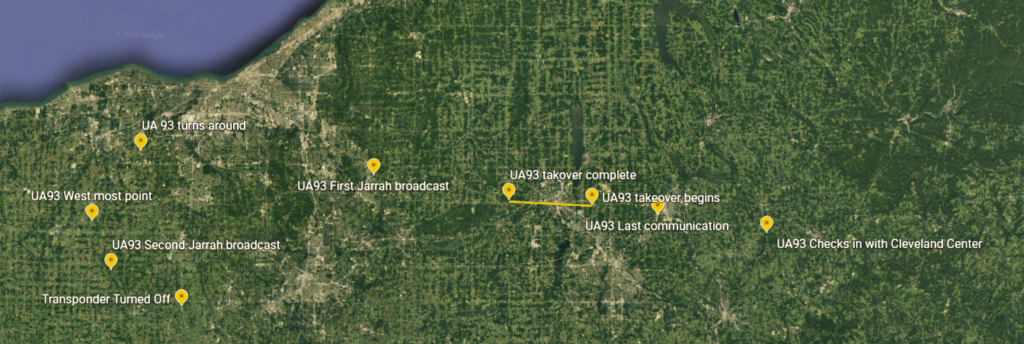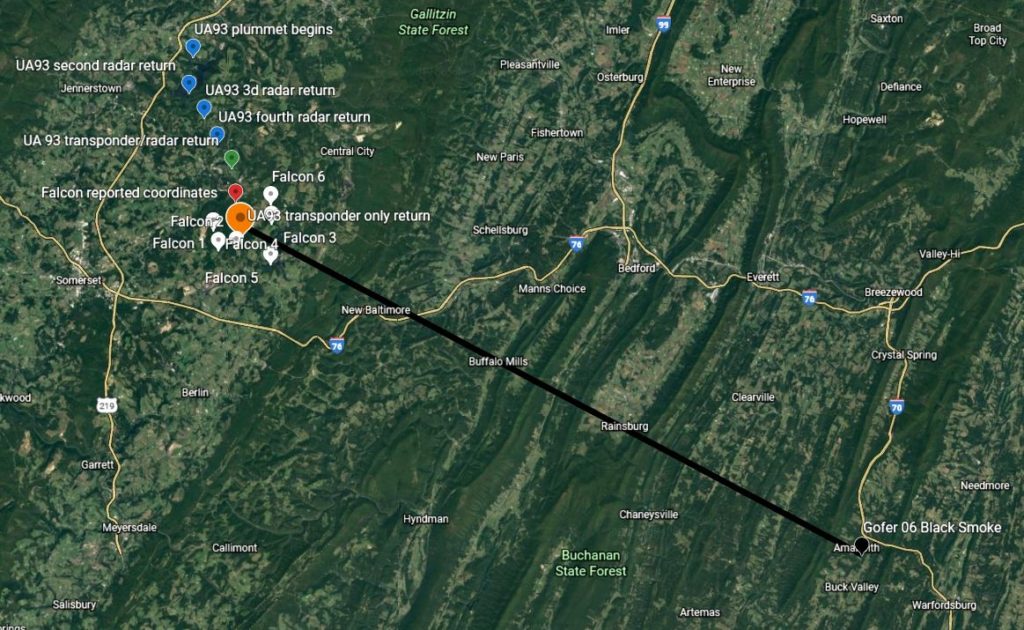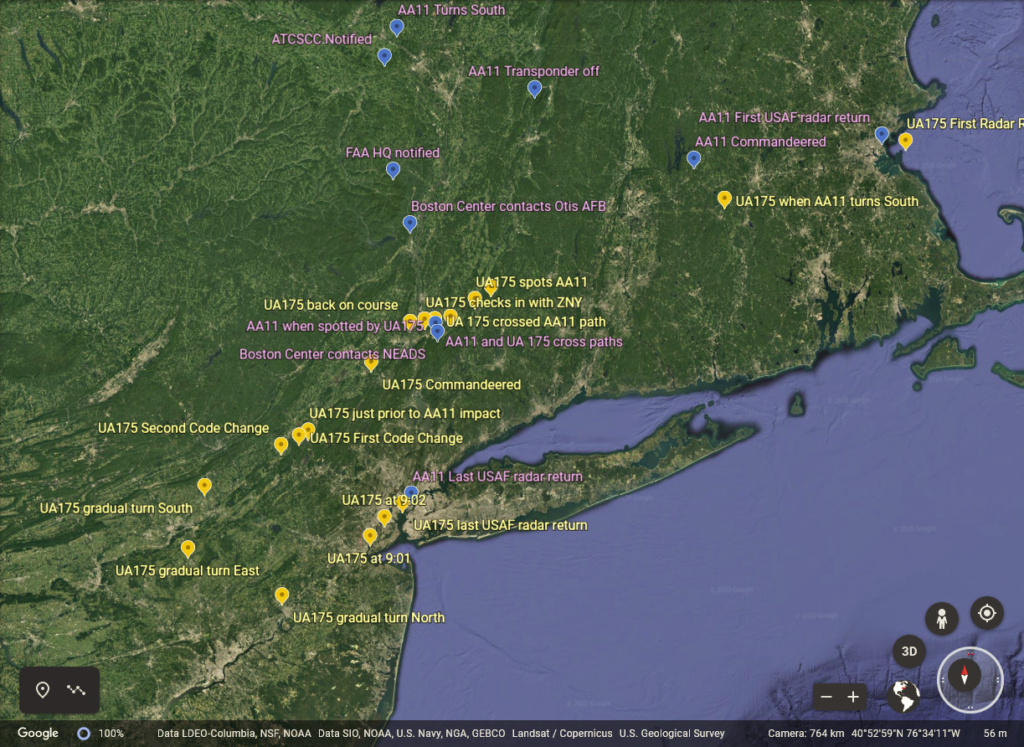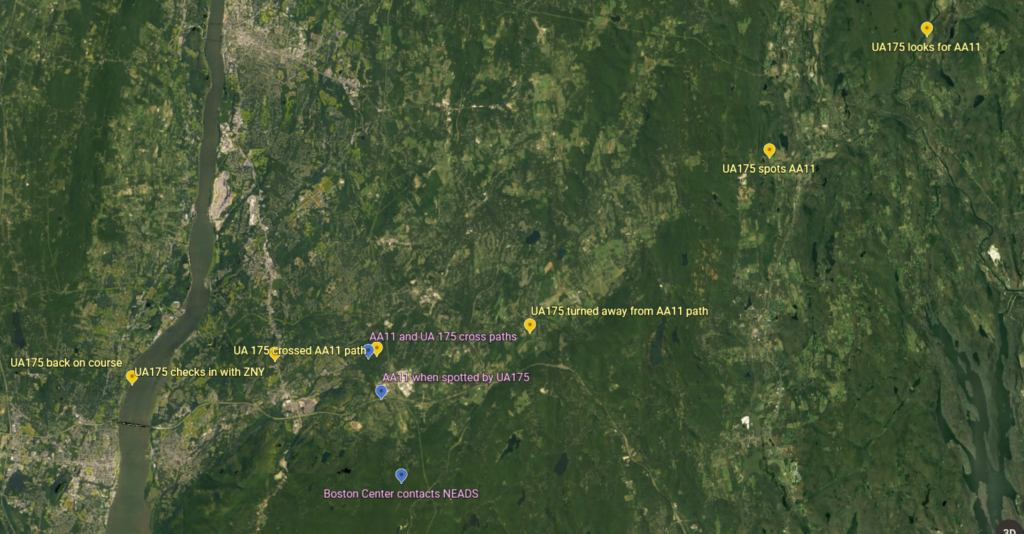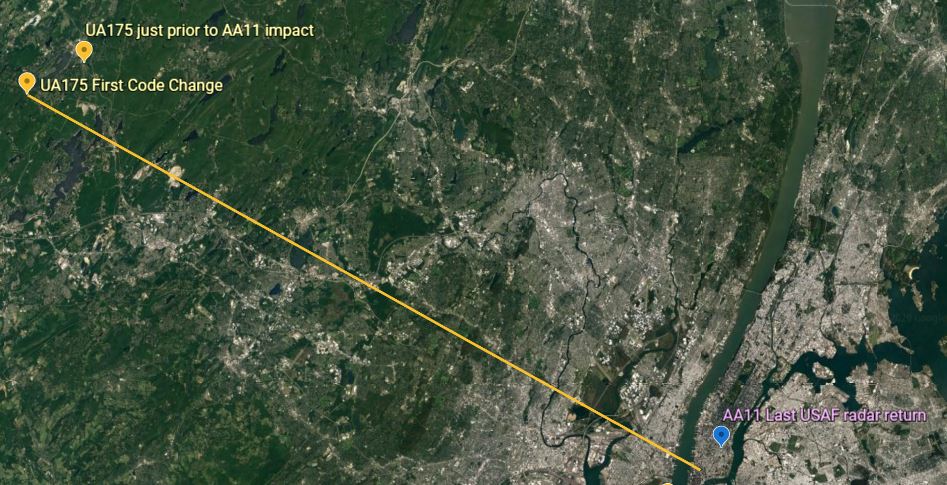On September 11, 2001, the fog of war concerning United Airlines flight 93 settled on the President’s Emergency Operations Center, Vice President Cheney, Transportation Secretary Norman Mineta, Federal Aviation Administration Administrator Jane Garvey and her Acting Deputy, Monte Belger, and the Secret Service.
Simply put, that fog increased significantly the higher up the chain of command and the closer United 93 apparently got to the nation’s capital. Ultimately, the National Command Authority was flying blind with no coherent picture of events as they were occurring.
Information, however, was precise on board United 93 as captured by the cockpit voice recorder and the flight data recorder, both recovered and readable.
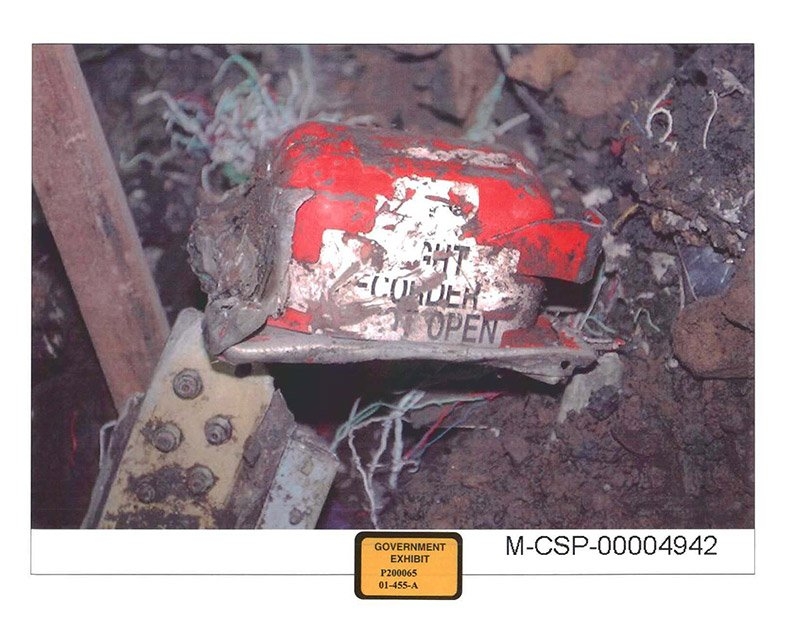
Government Exhibit at Moussauoi Trial
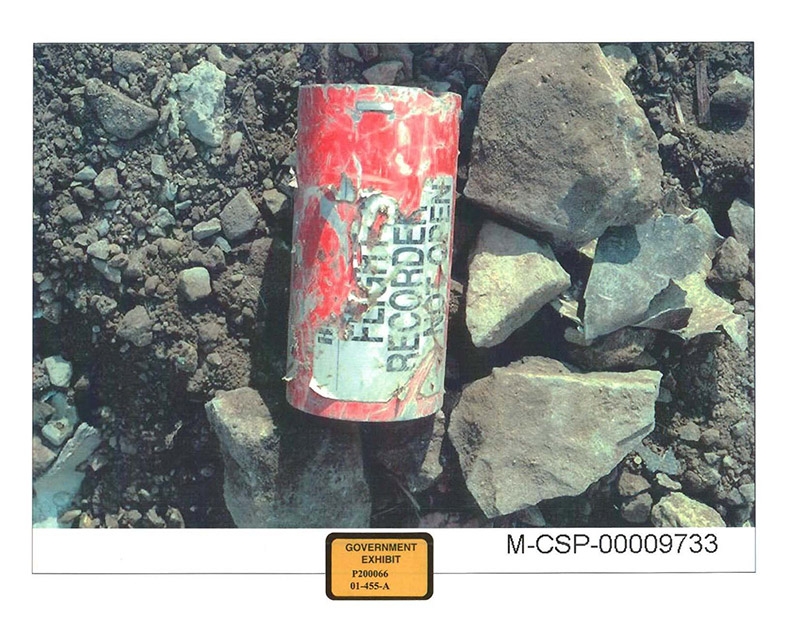
Government Exhibit at Moussauoi Trial
United States Air Force and Federal Aviation Administration (FAA) radar also provided precise data concerning United 93. That precise information was clear to air traffic controllers and was passed up the chain of command with clarity via two open telephone lines.
Cleveland Center established an open line to the FAA’s Air Traffic Control System Command Center, hereafter Command Center. Command Center maintained an open line to the FAA’s Washington Operations Center (WOC).
None of that precision and clarity survived the next step, informing the National Command Authority. This article documents the precision and clarity and explains the confusion of the fog of war.
The Precision
No one had more precise information than the passengers and remaining crew aboard United 93. They had complete situational awareness, knew their fate, and knew what they had to do. And they did it; individual and collective bravery forced United 93 to the ground well short of its intended target, the capital building.
Here is the United 93 seating chart as depicted on the United 93 memorial website.
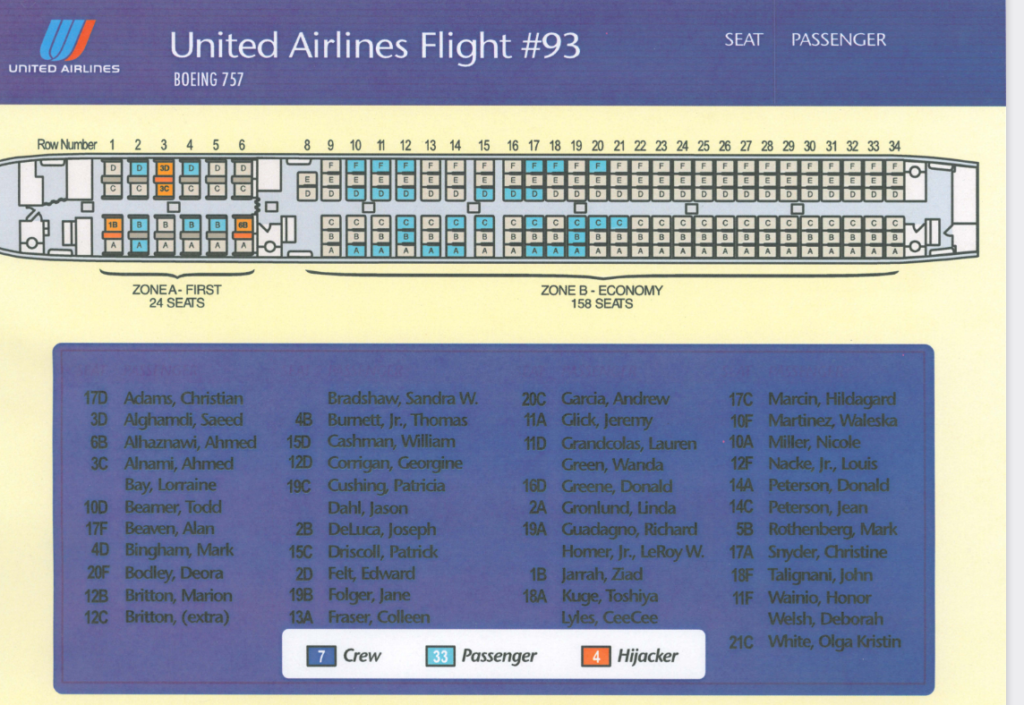
Government Exhibit, Moussaoui Trial
The flight data recorder preserved precise documentation. Recorder parameters started oscillating at 9:58 when the aileron and rudder sensors began fluctuating. Two minutes later the autopilot turned off and the pressure altitude fluctuated upward. By 10:00 United 93 was unstable in the air.

Readout
The cockpit voice recorder also provided precise documentation. Seconds after United 93 became unstable someone in the cockpit said, “Is that it? Shall we finish it off?” “No, not yet” was the answer. That changed in the next half-minute. Beginning at 10:00:29, someone, presumably Ziad Jarrah, said, “Up, down. Up down. Up, down. Saeed, up, down.” Saeed al Ghamdi was one of the hijackers that had commandeered United 93 a half-hour earlier.
In that same time frame an, observer, a visual flight rules plane, sighted United 93 and first reported, “Northwest bound, waving wings,” and then, “back towards the East, 80 heading, erratic.”
At 10:01:09, someone in the cockpit said, “Yes, put it in it, and pull it down.” A forensic analysis of Air Force radar depicted that United 93 ceased to fly and began a plummet to earth at about that time.

Commission File RDoD04021435
By 10:02, the flight data recorder readout showed that pressure altitude was decreasing and air speed was fluctuating. Shortly thereafter, Air Force radar regained radar contact which had been lost about 13 minutes earlier. Concurrently the observer aircraft reported, “back toward the Southeast, not progressing.”
At 10:02:45, Air Force radar detected the transponder (green dot in above image). A second return, 12 seconds later at 10:02:57, detected the transponder but no radar contact (red dot in above image). By 10:03, air traffic control reported that the transponder was back on.
Thereafter, voices from the cockpit continuously shouted “Allah is the Greatest”, ceasing at 10:03:09. By 10:03:11 the flight data recorder ceased recording parameters. Department of Defense space sensors detected an infra-red event between 10:03:10-11, with peak intensity at 10:03:16.

Mandatory Declassification Review Case 70401
Both the National Traffic Safety Board and the 9/11 Commission Report established the time of impact as 10:03:11.
The Clarity
At 10:03:10, Cleveland Center, Imperial Radar Position, reported radar lost. By 10:06, Cleveland reported to Command Center that they had lost United 93. Last known position was 16 nautical miles south of the Johnstown VOR (Very high frequency omni-directional range). At 10:07:27, Cleveland reported black smoke from that area, and at 10:09:12 reported coordinates, 39 51N 07 8 46W. At 10:12:37 Cleveland confirmed a downed aircraft.
For its part, Command Center passed that same information to the WOC at FAA headquarters. At 10:06:18 the Center reported that radar contact was lost followed quickly by the location, 16 nautical miles south of Johnstown. The black smoke report was forwarded by 10:08, followed two minutes later by the coordinates. At 10:13:20, Command Center confirmed a downed aircraft to the WOC. At 10:18 a voice is heard in background at the Operations Center confirming the United 93 coordinates to someone.

Cleveland Traffic Management Unit
Command Center, East TMO Position
Clear, relevant information was passed to FAA Headquarters within 10 minutes after United 93 impacted. All the precision of the event and reporting clarity became confusion at the highest levels.
The Confusion
We begin with the National Command Authority.
The President. “Dick called back a few minutes later. Condi, Josh Bolten, and senior members of the national security team had joined him in the PEOC. They had been informed that an unresponsive plane was headed toward Washington.” (Bush, Decision Points, 2010, p 129-30)
The Vice President. “At around 10:03 a.m., barely five minutes after Cheney walked into the conference room, United 93 took on a third identity…This time it was an unknown jetliner racing toward Washington at five hundred miles an hour. By then the plane had already crashed… But the Federal Aviation Administration, apparently relying on a projection after losing live radar data, issued rapid updates on the phantom bogey. The plane was eighty miles out, then sixty, then ten.” (Gellman, Angler, The Cheney Vice Presidency, 2008, p. 119)
The Secretary of Defense. The Secret Service, with the support of Vice President Cheney, advised Bush not to return to Washington until the situation was clarified. We were receiving unverified reports of hijacked airliners heading toward U.S. cities. Targeting the White House remained a possibility.” (Rumsfeld Known and Unknown, A Memoir, 2011, p. 338.)
The National Security Advisor. “Sometime after the order was given [shootdown] Norm [Mineta] was told that a plane had disappeared from the air traffic control radar. It was United Airlines Flight 93.” (Rice, No Higher Honor, 2011, p. 74)
Immediately below the leadership in the chain of command was Richard Clarke, National Coordinator for Security, Infrastructure Protection and Counterterrorism. Clarke convened the Secure Video Teleconference System (SVTS) that morning.
Clarke recalled that the SVTS started as early as 9:28. However, logs show that Administrator Jane Garvey and Director of Central Intelligence George Tenet did not join until 9:40. Nevertheless, Clarke wrote, “Okay,” I began. “Let’s start with the facts. FAA, FAA, go.” “Jane Garvey, the administrator of the Federal Aviation Administration, was in the chair.”
This was before the Pentagon was hit, according to Clarke.
Then, Clarke resumed, “FAA, FAA, go. Status report. How many aircraft do you still carry as hijacked?” Garvey read from a list… “Here’s what we have as potential hijacks: Delta 1989 over West Virginia, United 93 over Pennsylvania.”
Later—Ralph Seigler stuck his head around the door: “Secret Service reports a hostile aircraft ten minutes out.”. Then, “hostile aircraft eight minutes out.” (Clarke, Against All Enemies, Inside America’s War on Terror, 2004, pp 3-10)
I operated an SVTS link after the system was built in the 1986-1987 time-frame. Activation and operational are two separate steps. Once activated it takes time to turn on the lights, fire up the computers, and convene a conference. The Commission Staff accepted 9:40 as the conference start time, based on logs of the day.
Confusion began with the convention of that conference and it continued into the aftermath as individuals recalled events of the day. It was left to the 9/11 Commission to sort things out.
The Commission
“At 10:02, the communicators in the shelter began receiving reports from the Secret Service of an inbound aircraft—presumably hijacked—heading toward Washington. That aircraft was United 93. The Secret Service was getting this information directly from the FAA. The FAA may have been tracking the progress of United 93 on a display that showed its projected path to Washington, not its actual radar return. Thus, the Secret Service was relying on projections and was not aware the plane was already down in Pennsylvania.” (The Commission Report, p. 41)
Monte Belger, the Acting Deputy Administrator, was the most likely source of the FAA reporting. Belger did not have access to a radar display, only a TSD (Traffic Situation Display), a projection. Despite his reliance on TSD information, near real-time accurate information was provided to the FAA WOC, as discussed earlier. Accurate information was passed verbally to and within the WOC. There is no evidence that it was passed to Belger.
The Commission Reported the following conversation at 9:49 EDT. (p 29)
Headquarters to Command Center: “They’re pulling Jeff away to go talk about United 93.” (Jeff Griffith, Deputy Director of Air Traffic), the senior air traffic control official at FAA Headquarters.
Griffith was called away just before accurate information about United 93 began flowing to FAA Headquarters.
Belger said this when interviewed by Commission Staff, Team 8:
“Belger commented that he believes the only Traffic Situational Display (TSD) at FAA Headquarters was in the WOC. He does not know of any other TSD locations. [Note: Commission staff has learned that there are numerous TSD displays at FAA Headquarters, including the one referred to by Belger.] According to Belger, someone with air traffic experience would never use a TSD for precise data. (emphasis added) When the airspace was cleared, the WOC used the TSD to monitor the number of aircraft still airborne”. (Interview, April 20, 2004)
Transportation Secretary Norman Mineta confirmed Belger, in part, in a September 11, 2016 interview on MSNBC. (https://www.msnbc.com/msnbc-news/watch/fmr-transportation-secy-recalls-9-11-from-wh-762662467869) Mineta stated that when he first learned of events he was having breakfast in his office with a foreign dignitary and Administrator Jane Garvey.
Thereafter, he was called to the White House, conferred briefly with Clarke in the White House Situation Room, and then was escorted to the PEOC. There he sat opposite the Vice President and was in communication with Belger. Mineta’s account conflates information concerning United 93 to pertain to American 77. He did confirm that Belger said FAA lost radar contact with United 93. Thereafter, however, Mineta’s recall is that Belger was relaying information that could have only come from a TSD.
So, what happened?
We may never know. Mineta’s own testimony to the Commission and his recall has been consistently inconsistent. Information concerning American 77 and United 93 became conflated, inextricably.
The significant intervening variable was Clarke’s convention of an SVTS conference. That isolated Garvey from her staff and, as the Commission reported, they had to be called away from the FAA Operations Center to confer with her. Concurrently, Mineta was talking to Belger, not Garvey.
Belger knew from air traffic control that United 93 was lost but somehow decided to pass along TSD information to Mineta. None of the relevant information—transponder lost, black smoke reported, site coordinates, aircraft confirmed down—made it to Mineta and the National Command Authority.
The Commission reported that the PEOC was getting its information from the Secret Service.
Dense fog, impenetrable, enveloped the National Command Authority. It has yet to clear.

